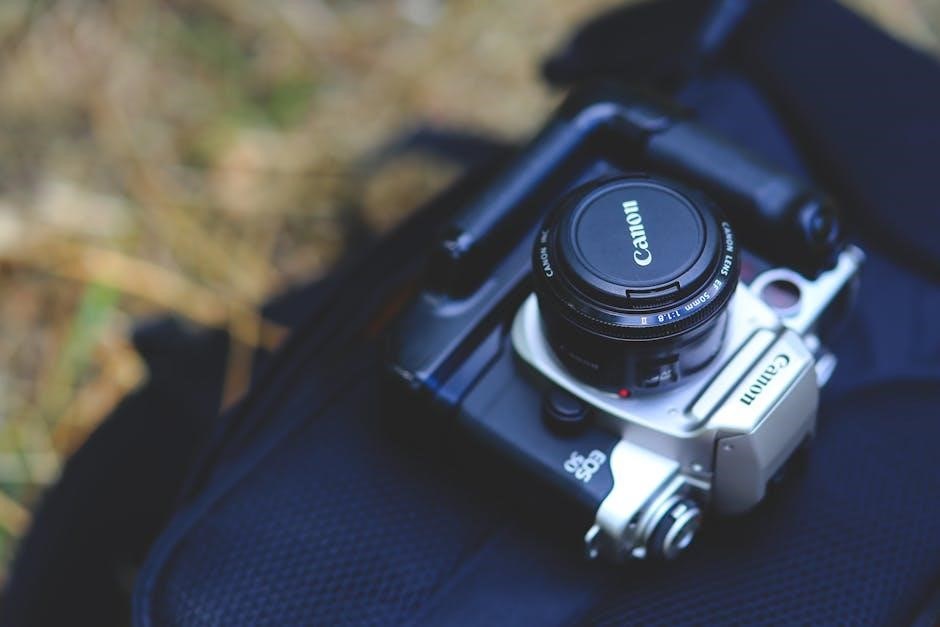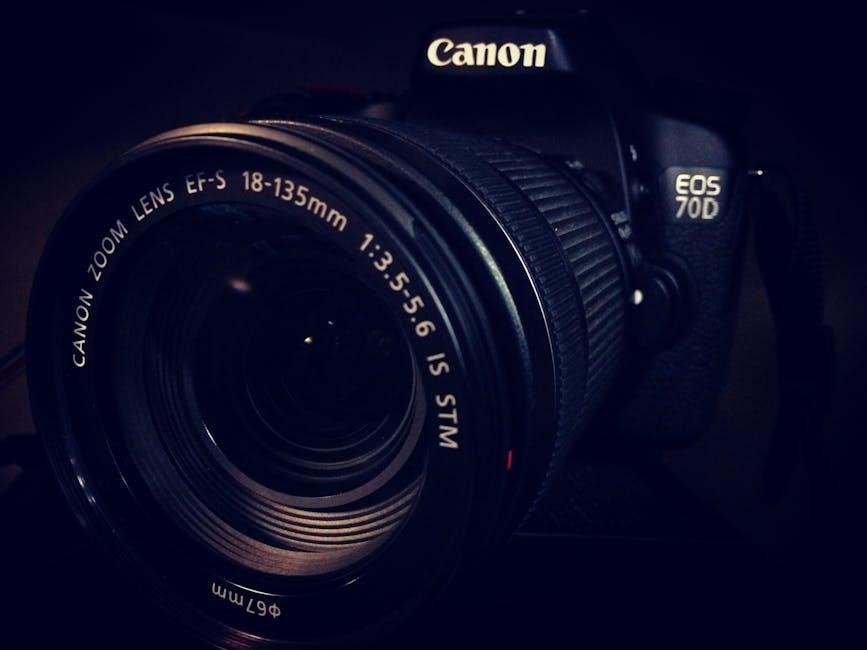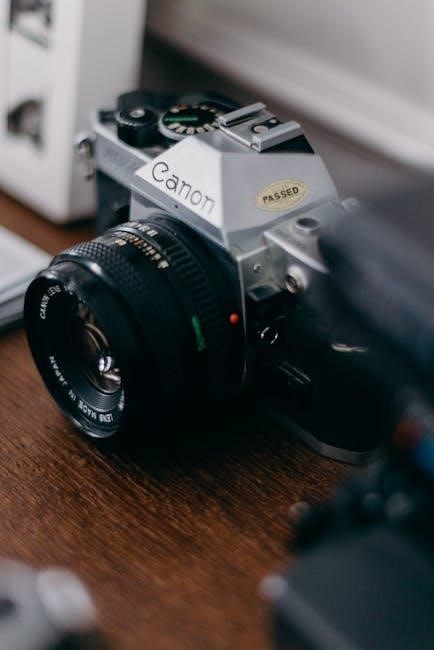Welcome to the world of the Canon RX100! This section serves as an introduction to understanding and utilizing the comprehensive manuals available for your camera. Whether you’re a beginner or an experienced photographer‚ these resources will unlock its full potential.

Understanding Basic Operations
Before diving into advanced features‚ mastering the basic operations of your Canon RX100 is essential. This section will guide you through powering on/off‚ navigating the menu‚ understanding the display‚ and capturing your first photos. Familiarize yourself with these fundamental steps for a smooth start.
Initial Setup and Navigation
Let’s begin by setting up your Canon RX100 for the first time. This involves several key steps to ensure your camera is ready to capture stunning images. First‚ you’ll need to insert the battery and memory card. Refer to your manual for the correct orientation and ensure they are securely in place. Next‚ power on the camera using the power button‚ typically located on the top of the camera body.
Once the camera is on‚ you’ll be prompted to set the date and time. This is crucial for accurate photo organization and timestamping. Use the directional buttons or the control dial to navigate through the options and adjust the values accordingly. Confirm your selections to save the settings. Now‚ let’s explore the menu system. Press the ‘Menu’ button‚ usually located on the back of the camera‚ to access a wide range of settings and customization options.
The menu is organized into different tabs‚ such as ‘Shooting’‚ ‘Playback’‚ ‘Setup’‚ and ‘My Menu’. Use the directional buttons or control dial to navigate between these tabs. Within each tab‚ you’ll find various settings related to that category. For example‚ the ‘Shooting’ tab contains options for image quality‚ ISO‚ white balance‚ and shooting modes. The ‘Playback’ tab allows you to review and manage your photos and videos. The ‘Setup’ tab includes options for date/time‚ language‚ display settings‚ and other general camera settings.
The ‘My Menu’ tab is a customizable section where you can add your most frequently used settings for quick access. To select a setting‚ use the directional buttons or control dial to highlight it and then press the ‘Set’ or ‘OK’ button to confirm your choice. Some settings may have sub-menus or options that require further navigation. Pay close attention to the on-screen prompts and indicators to understand the available options.
The control dial around the lens can be used for various functions‚ depending on the shooting mode. In aperture priority mode (Av)‚ it controls the aperture‚ while in shutter priority mode (Tv)‚ it controls the shutter speed. In manual mode (M)‚ it can control both aperture and shutter speed. Experiment with the control dial in different shooting modes to understand its functionality. Additionally‚ the rear control dial can be used to scroll through images in playback mode or to adjust settings in the menu.
Familiarize yourself with the different display modes by pressing the ‘Display’ button. This button cycles through various display options‚ such as showing or hiding shooting information‚ histograms‚ and grid lines. Choose the display mode that best suits your shooting style and preferences. Understanding the initial setup and navigation of your Canon RX100 is the foundation for mastering its advanced features and capturing exceptional images. Take your time to explore the menu and experiment with the various settings to customize the camera to your liking. Remember to consult your manual for detailed explanations and troubleshooting tips.

Advanced Shooting Modes and Settings
Now that you’re familiar with the basics‚ let’s delve into the advanced shooting modes and settings of your Canon RX100. These features allow for greater creative control and can significantly enhance your photography. This section will guide you through the intricacies.
Manual Mode (M) Mastery
Taking full control of your Canon RX100 means mastering Manual Mode (M). This mode empowers you to dictate both aperture and shutter speed‚ granting unparalleled creative freedom. It allows you to fine-tune your exposure for the perfect shot‚ regardless of lighting conditions. Understanding how these two elements interact is crucial.
Aperture: This controls the size of the lens opening‚ affecting both the amount of light entering the camera and the depth of field (the area of the image that appears sharp). A wider aperture (smaller f-number like f/1.8) lets in more light‚ creating a shallow depth of field ideal for portraits with blurred backgrounds. A narrower aperture (larger f-number like f/11) lets in less light‚ resulting in a greater depth of field‚ perfect for landscapes where everything is in focus.
Shutter Speed: This determines how long the camera’s sensor is exposed to light. Faster shutter speeds (e.g.‚ 1/1000th of a second) freeze motion‚ ideal for capturing fast-moving subjects. Slower shutter speeds (e.g.‚ 1 second or longer) allow more light to enter‚ creating motion blur or capturing detail in low-light situations. However‚ slower speeds require a tripod to avoid camera shake.
ISO: While not directly controlled in the same way as aperture and shutter speed in Manual Mode‚ ISO is a crucial element to consider. It determines the sensitivity of the camera’s sensor to light. Lower ISO values (e.g.‚ ISO 100) produce cleaner images with less noise‚ while higher ISO values (e.g.‚ ISO 3200) allow you to shoot in darker conditions but may introduce noise or grain into the image.
Putting it all Together: In Manual Mode‚ you must balance aperture‚ shutter speed‚ and ISO to achieve the desired exposure. Use the camera’s built-in light meter as a guide. If the meter indicates underexposure‚ you can either widen the aperture‚ slow down the shutter speed‚ or increase the ISO. Conversely‚ if the meter indicates overexposure‚ you can narrow the aperture‚ speed up the shutter speed‚ or decrease the ISO.
Practical Tips:
- Start with Aperture Priority (Av) or Shutter Priority (Tv) Mode: Before diving into full Manual Mode‚ practice adjusting either aperture or shutter speed while the camera automatically adjusts the other. This helps you understand the relationship between the two.
- Use a Tripod: When using slow shutter speeds‚ a tripod is essential to prevent camera shake and ensure sharp images.
- Pay Attention to the Histogram: The histogram is a graphical representation of the tonal range in your image. Use it to check for overexposure (highlights clipped on the right side of the histogram) or underexposure (shadows clipped on the left side).
- Experiment and Practice: The best way to master Manual Mode is to experiment and practice. Try shooting the same scene with different aperture and shutter speed combinations to see how they affect the final image.
- Consider MF Peaking Settings (Outline Emphasis): Utilize manual focus peaking to ensure your subject is sharp‚ especially when using wide apertures with shallow depths of field.
By mastering Manual Mode‚ you’ll unlock the full potential of your Canon RX100 and gain complete creative control over your photography‚ allowing you to capture stunning images in any situation.

Troubleshooting and FAQs
This section addresses common issues and frequently asked questions related to your Canon RX100; We aim to provide quick solutions and helpful information to keep you shooting smoothly; If you encounter a problem not covered here‚ consult the complete user manual or Canon’s support website.
Q: My camera won’t turn on. What should I do?
A: First‚ ensure the battery is properly inserted and fully charged. Try using a different‚ fully charged battery if available. If the issue persists‚ check the battery contacts for any dirt or debris and clean them gently. If none of these steps work‚ there may be a hardware issue‚ and you should contact Canon support.
Q: My photos are blurry‚ even in good light. What could be the problem?
A: Blurry photos can be caused by several factors. Ensure your lens is clean. Check your shutter speed – if it’s too slow‚ camera shake can occur‚ especially in low light. Increase the ISO or use a wider aperture to allow for faster shutter speeds. Also‚ verify that your focus mode is set correctly. For stationary subjects‚ use single-point AF. For moving subjects‚ use continuous AF. Finally‚ consider using image stabilization if your camera has it.
Q: The images on my LCD screen look different from the ones I see on my computer. Why?
A: This is common due to differences in screen calibration and color profiles. Your camera’s LCD screen may not be perfectly calibrated to match your computer monitor. To minimize discrepancies‚ calibrate your computer monitor using a color calibration tool. Additionally‚ ensure your image editing software is using the correct color profile (sRGB is a common and generally safe choice).
Q: How do I reset my Canon RX100 to its factory settings?
A: Navigate to the camera’s menu and look for the “Reset” or “Factory Reset” option. This will erase all custom settings and revert the camera to its original state. Be aware that this will also delete any custom picture styles or user profiles you’ve created.
Q: My camera is displaying an error message. What does it mean?
A: Consult your camera’s user manual for a list of error codes and their corresponding explanations. The manual will provide specific troubleshooting steps for each error. Common error messages relate to memory card issues‚ lens malfunctions‚ or internal system errors.
Q: How do I update the firmware on my Canon RX100?
A: Firmware updates improve camera performance and fix bugs. Visit the Canon support website for your specific camera model and download the latest firmware. Follow the instructions provided on the website to install the update. It typically involves copying the firmware file to your memory card and then initiating the update process through the camera’s menu. Ensure your battery is fully charged before starting the update process.
Q: My memory card is full‚ but I can’t seem to delete any files. What’s wrong?
A: Check if your memory card has a write-protect switch. If it does‚ ensure it’s switched to the unlocked position. Also‚ some images may be protected within the camera’s menu. Remove the protection from these images before attempting to delete them. If the problem persists‚ try formatting the memory card within the camera (be sure to back up any important files first).
Q: Can I use third-party accessories with my Canon RX100?
A: While many third-party accessories are compatible‚ it’s always recommended to use Canon-approved accessories to ensure optimal performance and avoid potential damage to your camera. Be particularly cautious with batteries and chargers‚ as using non-approved products can be risky.
If these troubleshooting steps don’t resolve your issue‚ please refer to your Canon RX100’s comprehensive user manual or contact Canon customer support for further assistance.

Firmware Updates and Software
This section outlines the importance of keeping your Canon RX100’s firmware updated and introduces the essential software that complements your camera. Regular firmware updates ensure optimal performance‚ bug fixes‚ and access to new features. Canon also provides software tools to enhance your photography workflow.
Understanding Firmware Updates:
Firmware is the embedded software that controls your camera’s functions. Canon regularly releases firmware updates to improve performance‚ fix bugs‚ and sometimes even add new features. These updates are crucial for maintaining the longevity and functionality of your RX100.
How to Check Your Current Firmware Version:
The process for checking your current firmware version will be detailed in your camera’s user manual. Typically‚ you’ll find this information within the camera’s menu system‚ often under a “Setup” or “Version Information” section. Note down the current version number.
Downloading Firmware Updates:
Visit the official Canon support website for your specific RX100 model. Navigate to the “Drivers & Downloads” or “Firmware” section. Locate the latest firmware update available for your camera. Read the release notes carefully to understand the improvements and fixes included in the update.
Installing Firmware Updates:
The update process usually involves downloading the firmware file to your computer‚ formatting a memory card in your camera‚ and then copying the firmware file to the memory card. Insert the memory card back into your camera and follow the instructions in the user manual to initiate the firmware update process. Important: Ensure your camera battery is fully charged before starting the update to prevent interruptions. Do not turn off the camera during the update process.
Canon Software Suite:
Canon provides a suite of software applications designed to enhance your photography workflow. These tools may include:
- Digital Photo Professional (DPP): A powerful image processing software for editing and managing your RAW images. DPP allows you to adjust white balance‚ exposure‚ color‚ and other parameters to achieve the desired look.
- EOS Utility: This software allows you to connect your camera to your computer and control it remotely. You can also use EOS Utility to transfer images and videos to your computer.
- Image Browser/ZoomBrowser EX: (Depending on your camera model) These applications provide basic image viewing and organization capabilities.
Downloading and Installing Canon Software:
The Canon software suite is typically available for download from the Canon support website. You may need to register your camera to access the software downloads. Follow the installation instructions provided with the software.
Utilizing Canon Software for Enhanced Workflow:
Explore the features of each software application to optimize your workflow. DPP is particularly useful for RAW image processing‚ allowing you to extract the maximum detail and dynamic range from your photos. EOS Utility can be helpful for studio photography or remote shooting situations.
By keeping your firmware updated and utilizing the available software tools‚ you can ensure your Canon RX100 operates at its best and unlock its full potential for capturing stunning images.